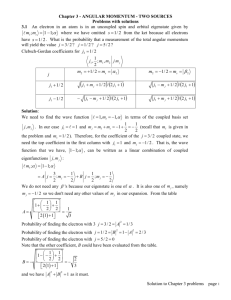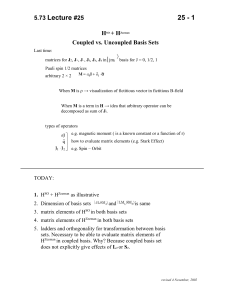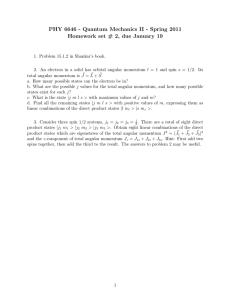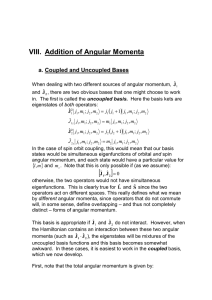MIT Department of Chemistry 5.74, Spring 2004: Introductory Quantum Mechanics II
advertisement
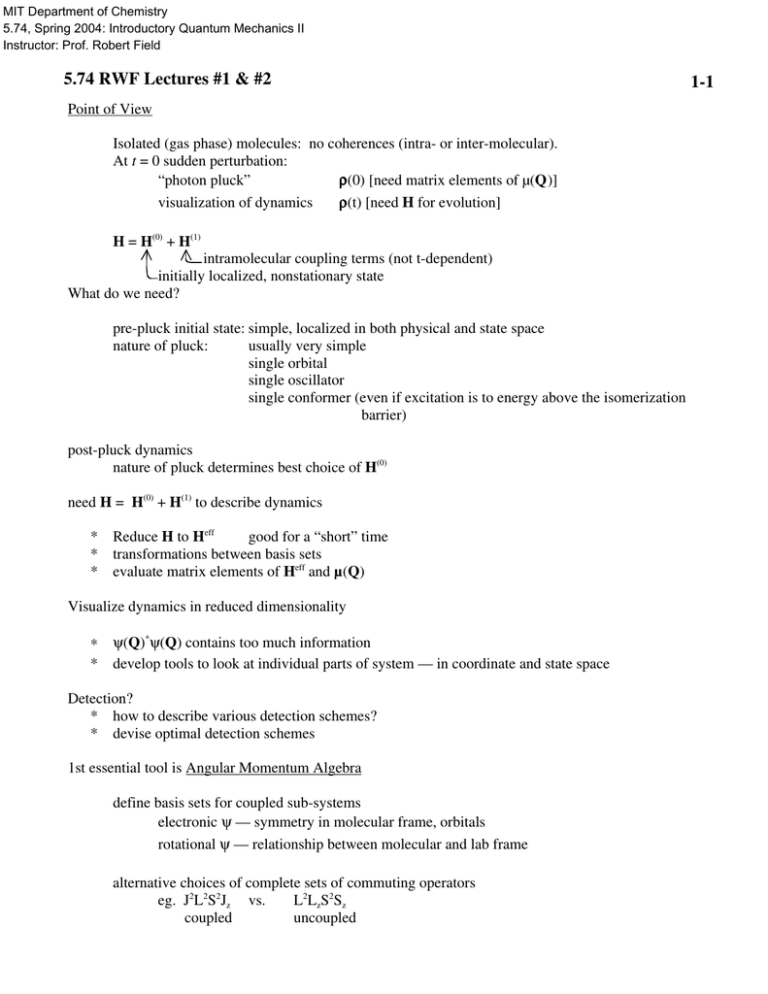
MIT Department of Chemistry 5.74, Spring 2004: Introductory Quantum Mechanics II Instructor: Prof. Robert Field 5.74 RWF Lectures #1 & #2 Point of View Isolated (gas phase) molecules: no coherences (intra- or inter-molecular). At t = 0 sudden perturbation: “photon pluck” ρ(0) [need matrix elements of µ(Q)] visualization of dynamics ρ(t) [need H for evolution] H = H(0) + H(1) intramolecular coupling terms (not t-dependent) initially localized, nonstationary state What do we need? pre-pluck initial state: simple, localized in both physical and state space nature of pluck: usually very simple single orbital single oscillator single conformer (even if excitation is to energy above the isomerization barrier) post-pluck dynamics nature of pluck determines best choice of H(0) need H = H(0) + H(1) to describe dynamics good for a “short” time * Reduce H to Heff * transformations between basis sets * evaluate matrix elements of Heff and µ(Q) Visualize dynamics in reduced dimensionality ∗ ψ(Q)*ψ(Q) contains too much information * develop tools to look at individual parts of system — in coordinate and state space Detection? * how to describe various detection schemes? * devise optimal detection schemes 1st essential tool is Angular Momentum Algebra define basis sets for coupled sub-systems electronic ψ — symmetry in molecular frame, orbitals rotational ψ — relationship between molecular and lab frame alternative choices of complete sets of commuting operators eg. J2L2S2Jz vs. L2LzS2Sz coupled uncoupled 1-1 5.74 RWF Lectures #1 & #2 1-2 reasons for choices of basis set nature of pluck hierarchy of terms in H transformations between basis sets needed to evaluate matrix elements of different operators effects of coordinate rotation on basis functions and operators spherical tensor operators Wigner-Eckart Theorem Let’s begin with a fast review of Angular Momentum Angular Momentum JM 2 J + 1 M values for each J 2 J , J z ,J ± = J x ± iJ y 1 ( J + J − ) real 2 + i J y = − ( J + − J − ) imaginary 2 [Ji , J j ] = ∑ ihε ijk J k Jx = k 1/ 2 (M ] 1) J ± JM = h[ J ( J + 1) − 1 ± M4 JM ± 1 243 product of M values If [A, B] = 0 then A ai b j = ai ai b j B ai b j = b j ai b j (if [A,B] ≠ 0, then it is impossible to define an |aibj⟩ basis set. e.g. Jx,Jy) 2 angular momentum sub-systems, e.g. L and S J=L+S two choices of basis set [ J 2 , L2 ,S 2 ,J z ] [L2 , L z ,S 2 ,S z ] LSJM J LM L SM S coupled uncoupled 5.74 RWF Lectures #1 & #2 1-3 trade J for ML (MS = MJ – ML) operators Lz, L±, Sz, S± destroy J quantum number (coupled basis destroyed) (not commute with J2) operators L±, S±, J± destroy ML, MS, MJ (both bases destroyed) example of incompatible terms in H special case valid only for ∆L = ∆S = 0 matrix elements H SO = ∑ ξ(ri )ll i ⋅ s i → ζ(NLS)L ⋅ S i H Zeeman = Bz µ 0 (L z + 2S z ) 1.4 MHz/Gauss note that HSO and HZeeman are incompatible because h [L z , L ⋅ S] = 2 [S z , L ⋅ S] = 2 h (L + S − − L − S + ) (L − S + − L + S − ) (note that if Hz were ∝ (Lz + Sz), the HSO and HZeeman simplified operators would commute and both would be diagonal in |LSJMJ⟩.) So we have to choose between coupled and uncoupled basis sets. Which do we choose? The one that gives a better representation of the spectrum and dynamics without considering off-diagonal matrix elements! (You are free to choose either basis, but one is always more convenient for specific experiment.) HSO lifts degeneracy of J’s in L–S state J=L+S J 2 = L2 + S 2 + 2L ⋅ S L⋅S = H Zeeman 1 2 h[ J( J + 1) − L(L + 1) − S( S + 1)] lifts degeneracy of MJ’s within J. E M J = gJ µ 0 Bz M J gJ = 1 + J ( J + 1) + S (S + 1) − L ( L + 1) 2J ( J + 1) 5.74 RWF Lectures #1 & #2 coupled limit 1-4 uncoupled limit off-diagonal HSO matrix elements ∆MJ = 0 ∆ML = -∆MS = ±1 ∆L = 0,±1 ∆S = 0,±1 H(0) = HSO H(0) = HZeeman (1) Zeeman H =H H(1) = HSO Landé interval rule. Patterns in both frequency and time domain get destroyed. Assignments are based on recognition of patterns. Selection rules for transitions get bent. Extra lines, intensity anomalies (borrowing, interference). We must do extra work to describe both ρ(0) and ρ(t). Limiting cases are nice simple patterns (sometimes too simple to determine all coupling constants — restrictive selection rules) easy to compute matrix elements dynamics is often simple with periodic grand recurrences Deviations from limiting cases terms that can no longer be ignored have matrix elements that are difficult or tedious to evaluate. Large Heff matrix must be diagonalized to describe dynamics. Atoms couple ni l i ml i si m si of each e– to make many-e– L–S–J state of atom electron orbital θ, φ lm l = Y m (θ, φ) l l spherical polar coordinates only one kind of coordinate system: origin at nucleus, z-axis specified in laboratory 5.74 RWF Lectures #1 & #2 1-5 (n1l 1 ) N (n2l 2 ) N 1 electronic configuration: 2 … individual spin-orbitals are coupled to make L–S–J states * Slater determinants * matrix elements of ∑ 1 rij i≠ j * Gaunt coefficients, Slater-Condon parameters: Coulomb and exchange integrals one spin-orbital is plucked by photon — generate perfectly known superposition of L–S–J eigenstates at t = 0 * explicit time evolution * problem set / LECTURE #1 STOPS HERE Coupled vs. Uncoupled Representations nLSJM J nLM L SM S 2 basis sets have same dimensionality Uncoupled (2L + 1)(2 S + 1) L +S ∑ Coupled J =|L – S| (2J + 1) = (2 L + 1)(2S + 1) ⇑ L−S ≤ J≤ L+S triangle rule What is happening here? ML,MS being replaced by J,MJ = ML + MS actually only one quantum number is being replaced by one quantum number convenient notation (especially for more complicated cases) unitary transformation: nLSJM J = LSM U M L =JM J − M S ,J ∑ M L = M J − M S ← ← conserved exchanged This sort of notation is useful for working out series of transformations nLM L SM S nLM L SM S nLSJM J completeness vector coupling or Clebsch-Gordan coefficient = = ∑ M L =M J −M S ∑ M L =M J −M S L nLM L SM S ( −1) L − S +M J (2J + 1)1/ 2 ML LSM U M L =JM J − M S ,J nLM L SM S replaced constructed S MS J –MJ 5.74 RWF Lectures #1 & #2 1-6 −1 Inverse transformation (unitary, so U–1 = U†, but U is real. U ij = U ji ) nLM L SM S = = = L +S ∑ nLSJM J nLSJM J nLM L SM S J = |L − S| L nLSJM J = M L + M S ( −1) L − S +M J (2J + 1)1/ 2 ML L +S ∑ J = |L − S| L +S ∑ J = |L − S| S MS J –MJ U J ,M LJ= M J − M S nLSJM J = M L + M S replaced LSM constructed General properties of 3-j coefficients j3 = j 1 + j 2 j1 j1 m1 j 2 m 2 j 3 m 3 ≡ ( −1) j1 − j 2 +m 3 (2 j 3 + 1)1/ 2 m1 special j2 m2 j3 −m 3 This is –m3 so that sum of bottom row = 0 m1 + m 2 = m 3 Be careful writing in opposite direction j1 m1 j2 m2 j3 j1 − j − m 3 −1/ 2 j1 m 1 j 2 m 2 j 3 − m 3 ≡ ( −1) 2 (2 j 3 + 1) m3 special properties: 1. even permutation of columns: +1 j +j +j odd permutation of columns: ( −1) 1 2 3 j + j + j 2. reverse sign of all 3 arguments in bottom row: ( −1) 1 2 3 Suppose one has j3 = j1 – j2 e.g. must reverse sign of ML in 3-j S=J–L J nJM J LM L SM S ≡ ( −1) J − L + M S (2S + 1)1/ 2 MJ L −M L S [note sum MJ – ML – MS = 0] −M S 5.74 RWF Lectures #1 & #2 1-7 Matrix Elements of H H is a sum of 2 parts, one easily evaluated in coupled basis and another easily evaluated in uncoupled basis H = H(1) (uncoupled) + H(2)(coupled) Must evaluate all of H in some basis set. Choose uncoupled. H( uncoupled ) = H(1)( uncoupled ) + T† H( 2 )( coupled )T LM L SM S = L +S LSJM J LSJM J LM L = M J − M S SM S 144444 42444444 3 ∑ J = |L − S| T J ,M L =M J −M S Want matrix elements of H(2): [T† H(2) coupled)T]LM = × = × L +S ∑ L ′+ S ′ L ∑ J = |L − S| J ′= |L ′− S ′| = M J − M S SM S ,L ′M L′ = M J′ − M S′ S ′M S′ LM L = M J − M S SM S LSJM J H(2) LSJM J ,L ′S ′J ′M J′ L ′S ′J ′M J′ L ′M L′ = M J′ − M S′ S ′M S′ L +S ∑ L ′+ S ′ ∑ J = |L − S| J ′=|L ′− S ′| L MJ − MS ( −1) L + L ′− S − S ′+M J +M J′ [(2J + 1)(2J ′ + 1)] 1/ 2 S MS J L′ − M J M J′ − M S ′ J′ H(2) LSJM J ,L ′S ′J ′M J′ − M J′ S′ M S′ alternatively, might want H(coupled). Need TH(1)(uncoupled)T† [TH(1) uncoupled)T† ]LSJM ,L ′S ′J ′M ′ J J = M J + S ≤L ∑ M J′ +S ′≤L ′ ∑ M L = M J − S ≥− L M L′ = M J′ − S ′≥− L ′ (or, if S > L, for MS = MJ – L ≥ –S to MS = MJ + L ≤ S) ( −1) L + L ′− S − S ′+M J + M J′ L × MJ − MS [(2J + 1) 2J ′ + 1)] 1/2 S MS J L′ − M J M J′ − M S′ S′ M S′ J ′ H(1) LM L SM S ,L ′M L′ S ′M S′ − M J′ 5.74 RWF Lectures #1 & #2 1-8 Other kinds of useful transformations 3-j are good to go from coupled↔uncoupled: trade J for ML or MS 6-j and 9-j are useful to go between different coupled basis set: trade one intermediate angular momentum magnitude for another Suppose you have 3 nonzero sub-system angular momenta s, l, and I (nuclear spin) Hmhfs = aI·j H = HSO + Hmhfs 1 l+s=j (ll + s)2 = j2 l ·s = 2[j(j+1) – l (l +1) – s(s+1)] j+I=F (j + I)2 = F2 j·I = 2 [F(F+1) – j(j+1) – I(I+1)] 1 interval rules assignment recurrent dynamics simple patterns when |ζ| >> |a|. Different kind of simple patterns when |a| >> |ζ|. 137 Ba sd 1,3D → s1,l1 = 0, s2, l2 = 2, I = 3/2 4 nonzero sub-system angular momenta! How do we transform between different ways of coupling these angular momenta? 5.74 RWF Lectures #1 & #2 1-9 6-j 3 fundamental angular momenta: a, b, c 3 possible “intermediate” angular momenta: e f g a + b = e a + c = f b + c = g 1 total angular momentum: F (my notation is different from that in Brown and Carrington) e.g. l+s=j j+I=F (HSO >> Hhfs) usual except for L = 0 states OR s+I=G G+l=F (Hhfs >> HSO) high Rydberg states of many-e– atoms with one e– in valence s-orbital a b c F ((a,b)e,c)FM F = ∑ ( a,(b,c)g)FM F [(2e + 1)(2g + 1)]1/2 (1) a+ b + c+ F g e g LHS: Couple a + b to make e, couple e + c to make F. RHS: couple b + c to make g, couple g + a to make F. 6-j is independent of MF. Projection quantum number defined for only total, F. To define a different projection quantum number instead of MF, must perform coupled → uncoupled transformations followed by uncoupled to coupled transformations. 6-j invariant under interchange of any 2 columns and upper and lower arguments of each of any 2 columns. 6-j can be expressed as product of 4 3-j’s. 9-j 4 fundamental angular momenta: a, b, c, d many possible intermediate angular momenta. a b ((a, d )g,(b,c)h )i = ∑ [(2e + 1)(2 f + 1)(2g + 1)(2h + 1)]1/2 d c g h e f ( (a, b)e,( d , c) f )i i LHS: a + d = g, b + c = h, g + h = i RHS: a + b = e, d + c = f, e + f = i (P is sum of all 9 arguments) multiply by (–1)P upon exchange of any 2 rows or columns 9-j unchanged by even permutation (123→231) of rows or columns or reflection about either diagonal 5.74 RWF Lectures #1 & #2 1-10 If one argument of 9-j is 0, reduces to a 6-j. Now go to the diatomic molecules electronic wavefunction rotational wavefunction two coordinate systems! Laboratory-fixed and molecule (body)-fixed. three angular momentum sub-systems LM L SM S RM R total orbital, total spin, nuclear rotation or more if we have Rydberg states. But L is never defined because a molecule is not spherical. We get Λ but not L! R N+ = R + Λ+ k̂ + Λ+ is L z N = N+ + lz lz J=N+S R=J–L–S S S+ nuclear rotation total angular momentum of ion-core exclusive of electron spin projection of L+ on bond axis (z) total angular momentum exclusive of electron spin projection of Rydberg e– orbital angular momentum on z-axis total angular momentum total spin spin of ion-core. Many angular momenta. Many coupling schemes. Watson's idea: (ion - core)(Rydberg e – ) totals + Hund's coupling cases: a, b, c, d, e or ( a )b , for example. Hierarchy of Σ1 rij , HSO, HROT.

